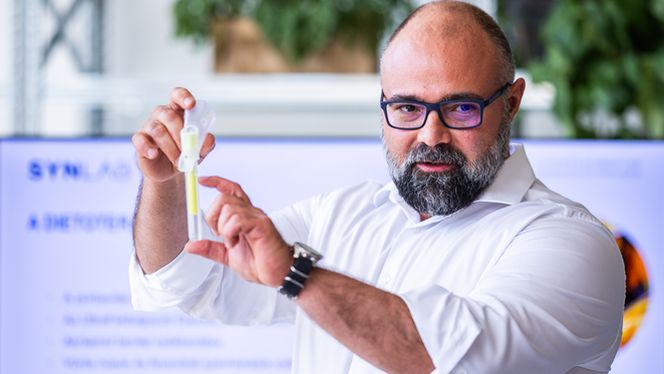Cervical cancer is one of the most common cancers among women, the fourth most common malignancy after breast, colorectal and lung cancer. Every year, 1,500 women are diagnosed with it, and nearly five hundred die because of it. The root cause of the disease has been known for decades: the most risky virus strains of the 200 known variants of the human papillomavirus, 16 and 18, are responsible for 70 percent of cancer cases. The disease could be almost completely prevented, but despite vaccination and screening programs, it has not been possible to radically reduce its incidence in recent decades. A new therapeutic method examining the gut and vaginal microbiome and a self-sampling test can help fight HPV and prevent cancer. The latest research results were presented with the participation of SYNLAB Hungary’s expert gynecologist and dietician.
The relationship between the microbiome of the gut and the cervix enables treatments that help prevent HPV and cure active infections – it was revealed at the SYNLAB Hungary press event, at which Máté Szász, biologist, SYNLAB’s sports and prevention professional director and Tamás Póda, SYNLAB’s commercial and marketing director presented the latest research results. At the professional discussion that followed, Virág Kovács, SYNLAB’s leading dietician, Dr. Ágnes Stefanovits, obstetrician-gynecologist, clinical oncologist, Fanni Dobó-Nagy and Lili Jani-Téglásy, founders of LIB Women’s Store, shared professional their experiences.
The number of cancer cases does not decrease
„In Hungary, about </span >5,500 people die from HPV-related diseases , for example, because of cervical, colorectal, oral, and pharyngeal tumors” said Dr. Ágnes Stefanovits, obstetrician-gynecologist, clinical oncologist. With vaccination against the virus and the use of effective screening methods, according to the WHO’s estimates, cervical cancer could be completely eradicated within a few decades, but according to epidemiological data, we are still not in a position to win in the fight against cancer caused by HPV. According to the data of the National Cancer Registry examining the past twenty years, the number of newly diagnosed cases of cervical cancer in Hungary has essentially not decreased, and the mortality due to cervical cancer has only decreased minimally in the last decade.
There are many misconceptions about HPV
Educational campaigns, vaccination and screening programs have contributed to increasing awareness of the disease, but the misconception that the virus only threatens women, while men are several times more likely to persist are also affected: they play a major role in the spread of infection, but they are also at risk from cancer.
In addition to the fact that HPV is the most common sexually transmitted virus, against which even condoms do not provide effective protection and the risk of infection exists with only one sexual partner, HPV is not only sexually transmitted . Since the virus is extremely heat-stable, drought-tolerant and resistant to several disinfectants, we can come into contact with it during, for example, using the bathroom and towels, taking a sauna, and even during medical examinations. It is estimated that 80% of the world’s population will be infected at least once in their lifetime. Yet a strong stigma surrounds a positive HPV diagnosis, which further complicates effective treatment and prevention. “We find that women’s health and sexuality are still taboo. Instead of awareness and prevention, the affected people only go to the doctor in case of symptoms and are reluctant to talk about the health problems that affect their everyday life,” said Fanni Dobó-Nagy, one of the founders of the LIB Women’s Store.
It is also a harmful misconception that HPV is incurable, there is no therapeutic method for it, in the case of a positive diagnosis there is nothing to do but to hope that it does not develop, with frequent screening tests and cytology who has cancer. Due to the belief that they are powerless against infection, many people may feel that prevention and screening tests make no sense, and in the case of active sex, neither does vaccination. However, the majority of infections are temporary and can be overcome by a healthy immune system over a period of years. New research results enable new therapeutic methods that significantly speed up recovery.
New diagnostic and therapeutic options to combat HPV
„SYNLAB’s nationally available self-sampling HPV tests, in addition to regular gynecological and cytological examinations, can play a major role in timely recognition of infection and typing of virus strains. This easy-to-use test can detect 14 high-risk HPV infections. And the urine sample test is recommended for both women and men,” said Tamás Póda, SYNLAB’s commercial and marketing director.
In case of a positive diagnosis, you should definitely consult a specialist, but in addition to frequent screening tests, a new therapeutic method can now also help in prevention and recovery.
„We have found a natural ally in the form of a lactobacillus. In the last 10 years, 116 studies have confirmed that a healthy vaginal bacterial flora, which is closely related to the intestinal flora, significantly reduces the risk of not only bacterial, but also fungal and some viral infections. HPV infection is one of these,” said Máté Szász, biologist, professional director of SYNLAB sport and prevention.
The exact molecular mechanism as a whole is not yet clear, however, it is a confirmed fact in the medical profession that at least four mechanisms play a role in protection. “Lactic and butyric acid produced by bacteria activates the immune defense of the vaginal mucosa. The presence of bacteria, the so-called contact effect, strengthens the closing and protective function of the vaginal mucosa; the presence of bacteria affects the immune system, thanks to which the elimination of the existing viral infection is accelerated, and our body gets rid of the virus sooner. Healthy flora elements and bacteria inhibit the colonization of pathogenic bacteria, thus reducing the vagina’s tendency to infection,” added Máté Szász.
The process works the other way around: the changed vaginal biome increases the risk of viral infection and the viral infection itself also changes the vaginal biome, increasing the colonization of several other pathogens. “Certain types of bacteria are able to penetrate the tissues and reach other body cavities, so it can be explained that the stable source of the vaginal biome, the intestinal flora, is the necessary point of intervention. An optimal microbiome can therefore help to avoid or overcome viral infection,” added Dr. Ágnes Stefanovits, obstetrician-gynecologist, clinical oncologist.
With appropriate dietary therapy, the speed of HPV elimination can be multiplied. Over the course of 3 months, without diet therapy -7.7%, with diet therapy -25% elimination rate.1</ a> And defeating the virus more quickly reduces the risk of cancer.
This is how we can support the gut flora in fighting HPV
„In the same way as the HPV test, the vaginal biome can be tested with a self-sampling test. The subsequent bacterial genetic analysis helps to create a diet that supports the establishment of protective bacteria and to determine the appropriate specific probiotics. The effect of the diet therapy will be evaluated a quarter later by examining the vaginal biome,” added Virág Kovács, SYNLAB’s leading dietician.
The expert also drew attention to the fact that the appropriate microbiome composition varies from individual to individual, but there are typical patterns in the upset intestinal flora, which are more exposed to viral infections, and there are also foods that cannot be eaten by avoiding them.</p >
Reducing fat intake, excluding ultra-processed or preservative-treated foods, reducing acrylamide intake, reducing red meat and refined carbohydrates can all help to create an optimal diet. While certain special micronutrients, carotenoids, lycopene, vitamin E, Omega-3 fatty acids, flavonoids, plant enzymes, phytoestrogens and fibers have a supportive effect on the microbiome.
Source: Positive Adamsky















